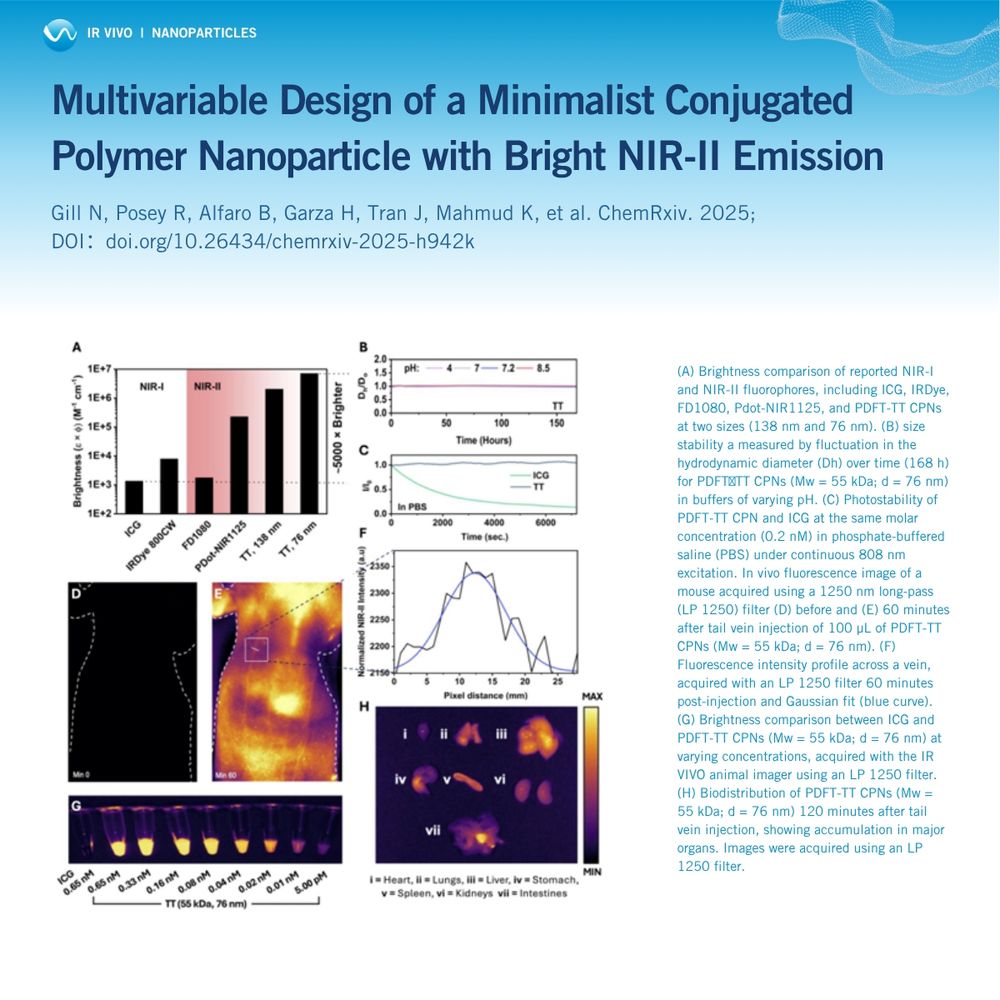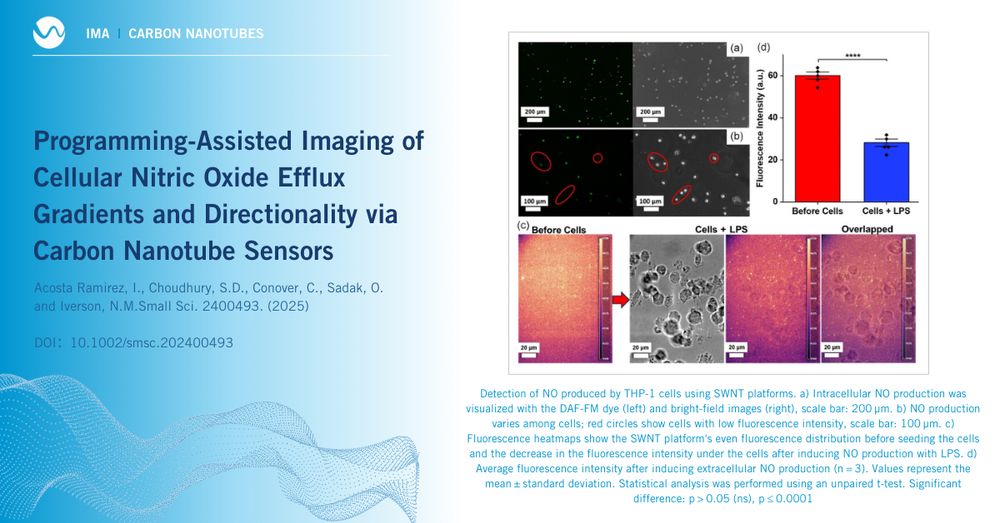
To learn more 🔗 pubs.acs.org/doi/10.1021/...
17.09.2025 19:19 — 👍 0 🔁 0 💬 0 📌 0@photonetc.bsky.social
Photon etc. is a renowned Quebec company specializing in the design and manufacture of hyperspectral and infrared imaging systems.

To learn more 🔗 pubs.acs.org/doi/10.1021/...
17.09.2025 19:19 — 👍 0 🔁 0 💬 0 📌 0
Researchers from National Chung Hsing University,
@ucl.ac.uk and Queen Mary University of London used hyperspectral imaging and real-time photoluminescence to uncover how a chaotropic agent (guanidinium thiocyanate) modulates the crystal growth of tin–lead (Sn–Pb) halide perovskites.
Details 👇

This recent study, using our IR Vivo, introduces ultrabright protein-complexed nanoprobes, developed through a unique combination of molecular and protein nanoengineering, and validated in clinically relevant large animal models
Read the full paper on bioRxiv 🔗 www.biorxiv.org/content/10.1...

This recent study presents a minimalist conjugated polymer nanoparticle (PDFT) with extraordinary brightness and photostability in the 950 nm region, outperforming many current NIR-II emitters, including ICG.
Completed, in part, thanks to our IR Vivo!
Read the full article here 👉 bit.ly/45cojBg

As we gear up for PVSC, we’re proud to spotlight a recent study from Prof. Stefaan De Wolf’s group that sheds new light on tin-based perovskites, a promising lead-free alternative for next-gen photovoltaics.
Read the full study here: pubs.rsc.org/en/content/a...

How can we improve the long-term stability of mixed-halide perovskites under light exposure?
In this recent study, researchers introduced low-cost polymer additives (corn starch and PVP) to suppress halide segregation and enhance photostability.
Read the full study: pubs.acs.org/doi/abs/10.1...

In this study from 2024, researchers introduced the RAINBOW architecture, a lateral multi-junction solar cell concept where each sub-cell receives a different part of the solar spectrum for optimal light harvesting.
To read the full article 🔗 bit.ly/43zU1YD
#LLTF

Recent research highlights the power of photocurrent spectroscopy to probe dark magnetic excitons in 2D antiferromagnetic semiconductors, revealing insights into the opto-spintronic properties of NiI₂ down to the bilayer limit. Evidence of multiferroicity in ultra-thin materials.
🔗 bit.ly/3F9Br1h

New research stemming from a collaboration between HTW Berlin, Helmholtz-Zentrum Berlin, and Photon etc. exploring how laser patterning affects perovskite solar cell performance during upscaling.
Read the full article here: www.mdpi.com/2673-9941/5/...

Milestone from Prof. Federico Capasso’s team at Harvard University, published in @nature.com: they introduced free-standing bilayer metasurfaces operating in the visible spectrum, enabling advanced wavefront shaping with impressive 80% diffraction efficiency.
Full article: go.nature.com/3EOz1oB

In this @nature.com study, researchers developed a novel nanocatalyst to synthesize conjugated polymers used to sort semiconducting single-walled carbon nanotubes (s-SWCNTs).
Our ClaIR was used to generate photoluminescence excitation-emission maps.
🔗 go.nature.com/3Yd7P9H

In a 2022 publication from NIST, researchers were able to visualize localized, radiative defects in high growth-rate GaAs solar cells across a broad temperature range (77 K to 300 K).
To read the full paper and discover the role of Photon etc.'s GRAND-EOS 👉 www.nature.com/articles/s41...

New study from Prof. Sam Stranks’ group at Cambridge published in @nature.com highlights how nanoscale disorder and interfacial quality directly impact the stability and performance of alloyed perovskite solar cells.
Read the paper and discover the role of our IMA 🔗 www.nature.com/articles/s41...

Research led by David Ginger’s group at the University of Washington, in collaboration with institutions including Eindhoven University of Technology and Georgia Tech uncovers how local halide heterogeneity drives surface wrinkling in wide-bandgap perovskites.
@nature.com 👉 go.nature.com/4i0qZqe

A recent study reveals luminescence alterations of AuNCs when interacting with different cell types, highlighting key factors like surface ligand disruption and protein interactions, crucial for optimizing AuNCs as reliable imaging and diagnostic tools.
For more info 🔗 pubs.acs.org/doi/10.1021/...

Discover the LightIR, the world's first and only versatile in vivo fluorescence imaging system for researchers designed for both closed and open environments.
Details 👉 www.photonetc.com/products/lig...
www.youtube.com/watch?v=7POb...

Research from Texas Tech University introduces 3D tumor-mimicking phantom models (TMPs) to better assess NIR-I/II nanoparticles for fluorescence-guided surgery. Our IR Vivo imaging system was used in this study and played a key role in analyzing NIR-II imaging performance.
Details 🔗 bit.ly/4bpiDXvv1

Research from Prof. Sam Stranks and his team explore the ultrafast quantum dynamics of halide perovskites, revealing picosecond quantum transients in scalable bulk formamidinium lead iodide films.
To read more and learn about our IMA's role in this paper🔗 arxiv.org/abs/2502.13609

Prof. Nicole Iverson and her team have created a carbon nanotube-based sensor that enables high-resolution imaging of nitric oxide (NO) diffusion gradients in cellular environments.
Photon etc.’s IMA played a key role in characterizing these single-walled carbon nanotubes.
Details 🔗 bit.ly/41IT00K

EMIM 2025 starts today! Meet Paul Dorval and Pierre-Alix Dorval at booth 325 to discover the Kratoscope from Kaer Labs (a company of Photon etc.), a fast and efficient tool for ex vivo 3D organ imaging.
Stop by to see it in action and learn how it can support your work!
📍 EMIM 2025 | Booth 325

Collaborative research has helped uncover key mechanisms in halide segregation for wide-bandgap perovskites, paving the way for more stable and efficient flexible perovskite solar cells.
Our IMA was used to identify and quantify material changes!
For more information 🔗 bit.ly/3D7YGI9

Prof. Ryan Williams and his team at City College of New York have developed a near-infrared optical nanosensor for rapid and accurate estrogen receptor (ER) detection. With an AUC of 0.94, the results are promising for future field-deployable molecular profiling.
To read more 👉 bit.ly/41zp8nn

Prof. Ryan Williams and his team at City College of New York have developed a near-infrared optical nanosensor for rapid and accurate estrogen receptor (ER) detection. With an AUC of 0.94, the results are promising for future field-deployable molecular profiling.
To read more 👉 bit.ly/41zp8nn

Professor Luc Stafford and researcher Fatima Khazem from Université de Montreal, recently showcased their latest publication: "Hyperspectral imaging of a microwave argon plasma jet expanding in ambient air."
To discover how the V-EOS was used to study a microwave plasma jet, watch the video below 👇

Professor Stefaan De Wolf and his team have pioneered the use of solvent-dripping modulated 3D/2D heterostructures, enhancing the efficiency and durability of perovskite solar cells.
Learn about this breakthrough published in @nature.com and our IMA's contribution 🔗 www.nature.com/articles/s41...
Photon etc.’s products we're highlighted in over 7 @nature.com publications in 2024! From enhancing solar cell efficiency to innovating cancer diagnostics, our technology is contributing to scientific research across a spectrum of fields.
To learn more 👉 www.photonetc.com/scientific-p...

New study from teams of the University of Rhode Island and Brown University utilizes NIR fluorescence spectral fingerprinting and machine learning to explore the interactions between DNA-functionalized single-walled carbon nanotubes (DNA-SWCNTs) and macrophage cells.
🔗 pubs.acs.org/doi/abs/10.1...

New perovskite research from Arizona State University, professor Nick Rolston and his team employed open-air blade-coating, integrating corn starch to enhance durability and mechanical stability of perovskite films.
To read more and discover the role of our IMA 🔗 www.mdpi.com/2227-9717/12...

New study featured in @nature.com revolutionizes perovskite photovoltaics by creating a photo-ferroelectric perovskite interface that significantly enhances the open circuit voltage (VOC) through novel interface engineering.
Amazing work that uses our IMA 👉 www.nature.com/articles/s41...

New research from the University of Twente details a significant advancement in the field of solar energy, showcasing perovskite solar cells with enhanced power conversion efficiencies exceeding 19%.
To read the study and explore how our IMA contributed 🔗 www.cell.com/joule/abstra...